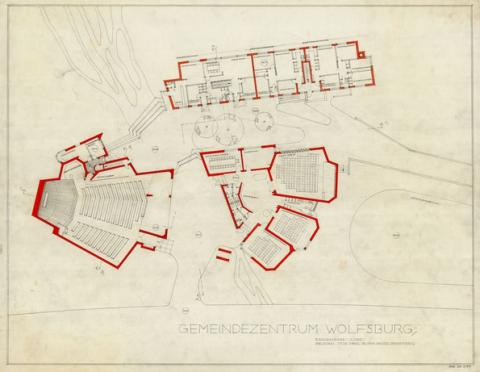Based on a Cambridge Humanities Research Grant Maximilian Sternberg and Gates scholar Sofia Singler have worked on a project entitled ‘The civic and the sacred Alvar Aalto’s churches and parish centres in Wolfsburg (1960-1968).’ Sternberg and Singler examine Alvar Aalto’s urban ecclesiastical projects in Wolfsburg in relation to the role of religious identity in urban developments in West Germany. Even though Aalto is widely recognised as the leading Nordic modernist architect of the twentieth century, his German church designs have received little attention in the Anglophone or Nordic literature. This study redresses this imbalance by analysing how Aalto adapted his approach to sacred space and religious communal facilities, developed in Finland from the 1920s, to the specific circumstances and challenges of 1960s West Germany.
Aalto’s Finnish religious projects suggest that in addition to church officials and the architect’s office, national and local governments, industry and businesses, planners and parish members, among other actors, critically influenced post-war ecclesiastical architecture. The churches in Wolfsburg were Aalto’s opportunity to develop the ideas he had formulated in Finland in a number of key projects and competition entries, most notably the churches and parish centre complexes at Seinäjoki and Vuoksenniska, in a transnational Lutheran context. Through a close reading of Aalto’s church and parish centre complexes of of Heilig-Geist (1960–62) and St Stephanus (1963–68) in Wolfsburg and the conditions that shaped them, this study sets out to identify similarities and differences between the Finnish and German post-war Lutheran contexts, thereby interrogating and characterising spheres of international, national and local influences that shaped post-war religious architecture. Aalto’s architectural interpretation of the complex relationship between the sacred and the civic in the post-war period sheds light on the wider search for the communal and humanist meanings in late modernism.
The project has resulted in a co-authored journal article 'The Civic and the Sacred: Alvar Aalto’s Churches and Parish Centres in Wolfsburg (1960–68)', Architectural History 62 (2019): 205-36.

![Alvar Aalto research[1]](https://www.arct.cam.ac.uk/files/styles/large/public/media/alvar-aalto-research-1.jpg?itok=WeV3Nh-J)

![Alvar Aalto research 1[1]](https://www.arct.cam.ac.uk/files/styles/large/public/media/alvar-aalto-research-1-1.jpg?itok=yWj5xygG)